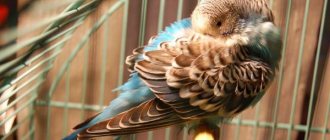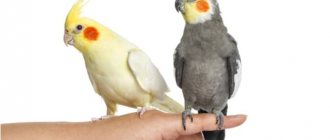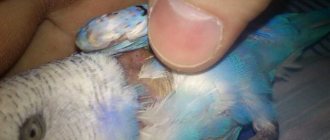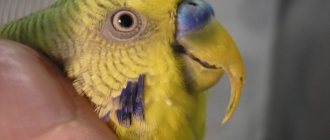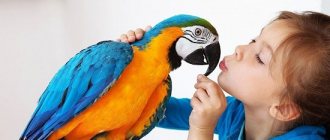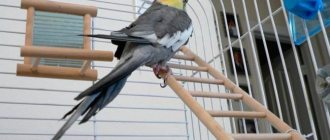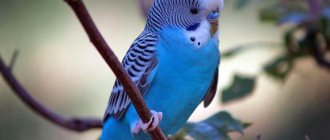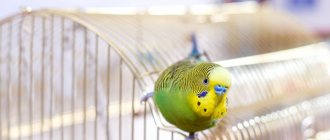“You will always be responsible for the one you have tamed”: folk wisdom, first heard from the lips of Antoine de Saint-Exupéry in the story “The Little Prince”, carries a huge meaning that is still popular in our time. Owning a pet is a responsible choice that must be made with all due care. Cute parrots are frequent guests of apartments and houses and require special care.
The procedures for purchasing a pet and cage are only the first step towards constant and proper communication with the future member of your family. Like any other poultry or animal, cockatiels run the risk of getting sick, although this happens quite rarely. The pet owner should consider in advance the question of exactly what diseases, infections and pathologies may appear in his pet, and how they can be dealt with.
Diseases of the gastrointestinal tract
Poor nutrition or infection are the main causes of stomach and intestinal diseases. Cockatiels experience diarrhea, constipation and vomiting. If such symptoms are detected, it is advisable to show the bird to an ornithologist as quickly as possible.
Diarrhea
Diarrhea in birds is often confused with polyuria, since their feces consist of feces and urine. Normally, cockatiel droppings do not spread out, but retain their shape. If there is liquid around it, it is nothing more than urine. With diarrhea, stool becomes liquefied. They may contain air bubbles, bloody inclusions and mucus.
Symptoms of diarrhea:
- frequent bowel movements with liquid, green stool;
- lethargy, depression;
- loss of appetite;
- weight loss
Diarrhea in cockatiels can occur due to various diseases of the gastrointestinal tract. Most often, the cause of stool disorder is poisoning with low-quality food, as well as:
- gastroenteritis;
- dysbacteriosis;
- diseases caused by bacterial infection.
Loose stool in a cockatiel should not be ignored. With diarrhea, the body quickly becomes dehydrated, which can cause the pet to die. A veterinarian must treat diarrhea, because the owner of the parrot cannot independently determine the true cause of the disease.
Depending on the diagnosis, the doctor may prescribe the following medications:
- Levomycytin;
- Polyphepan;
- Linux;
- Phthalazol;
- Activated carbon.
For diarrhea, the parrot is put on a diet. Sprouted grains, fresh herbs and fruits are temporarily excluded from the diet. Vegetables are given in small quantities. It is important to ensure that there is clean water in the drinking bowl.
Regurgitation of food
If your cockatiel is regurgitating food, you should pay attention to it. This behavior is the norm only in one case - if the bird feeds the partner it is caring for. Vomiting can be a symptom of various diseases and pathologies.
Most often it is caused by:
- poisoning;
- disturbances in the functioning of internal organs;
- goiter inflammation;
- tumor formations in the mediastinum;
- heart problems.
Attention! Vomiting and convulsions in a parrot are a very alarming symptom. It may indicate poisoning with toxic substances.
Sometimes vomiting in birds occurs due to such serious diseases as enteritis, vitelline peritonitis, salpingitis, and bornavirus infection. If your cockatiel parrot gets sick and starts regurgitating the food it has eaten, you should urgently contact an ornithologist.
Treatment will be prescribed only after diagnosis. As a rule, it includes following a diet, taking enterosorbents, and probiotics. Antibiotics or antifungal medications may also be prescribed.
Pushing food
Some cockatiel owners notice that their parrot yawns frequently. It opens its beak wide and stretches its neck. In fact, this is not yawning, but a symptom that indicates that the bird is feeling discomfort in the crop or chest area.
Yawning or pushing food can be a sign of narrowing or strain of the esophagus. This happens in chronic heart failure, when the heart increases in size and puts pressure on nearby organs. If your pet begins to stretch its neck, you need to take an x-ray to find out the cause of the discomfort and begin treatment.
Bird behavior changes
In their normal state, Corella parrots lead an active lifestyle - they make loud sounds, jump from place to place, and also love to walk and fly around open space. In addition, such birds quickly become attached to all household members and have good contact with other pets.
The fact that a cockatiel parrot has fallen ill is indicated by a change in the bird's behavior. He becomes lethargic, sleeps for a long time, loses coordination of movements or, conversely, behaves restlessly, hits the bars of the cage and screams. Proof that the pet is unhealthy is nervous pulling out of feathers, scratching of the skin and other signs.
Respiratory system diseases
The respiratory organs are another weak point in cockatiels and budgies. In most cases, diseases of the nose, bronchi and lungs are caused by pathogenic bacteria or viruses. Therefore, if the bird begins to sneeze or cough, it is necessary to schedule a visit to an ornithologist in the near future.
All cockatiel diseases that are associated with the respiratory system are often severe and can lead to lung damage.
Rhinitis
This is a disease in which the mucous membrane of the nasal cavity becomes inflamed. Symptoms of rhinitis in parrots:
- labored breathing;
- copious nasal discharge;
- the appearance of crusts near the nostrils;
- sneezing;
- loss of appetite.
A sick parrot opens its beak to breathe because its nasal passages are filled with mucus. He looks depressed and loses his appetite. The feathers of such a bird are disheveled and unkempt.
Attention! If the cockatiel develops another symptom against the background of rhinitis - inflammation of the conjunctiva, this is a sign of ornithosis, a disease caused by the intracellular microorganisms chlamydia. A sick parrot should be immediately placed in a separate cage if it does not live alone.
Treatment of rhinitis cannot be delayed, otherwise the inflammation will spread to the bronchi and lungs. A sick parrot is kept in a warm room. Twice a day his nostrils are cleaned of crusts and mucus. To thin the discharge, you can resort to steam inhalation with chamomile decoction. If therapy is ineffective, antibiotics are added to the treatment regimen to kill the infection.
Sinusitis
If the air cavities between the eyes and nostrils become inflamed in a cockatiel, we are talking about a disease such as sinusitis. Fortunately, its symptoms cannot go unnoticed:
- redness of the eyelids;
- inflammation of the conjunctiva;
- the appearance of bags under the eyes;
- the cockatiel shakes its head in pain and rubs against the cage;
- in advanced cases, pus begins to ooze from the eyes.
The main reason for the development of this disease is an infectious runny nose. Most often it is caused by pathogenic bacteria:
- Klebsiella;
- mycoplasma;
- chlamydia;
- Escherichia;
- aspergillus.
To treat sinusitis, antibiotics are prescribed by injection. The cockatiel also needs to wash its eyes with a chlorhexidine solution. It is recommended to include vegetables high in vitamin A into your diet.
Voice change
Any changes in the tone of the voice in cockatiels are a symptom of diseases of the respiratory system. When the air sacs become inflamed, parrots may hear soft clicking sounds when breathing. Such sounds can appear in various infectious diseases. Often, the cockatiel behaves normally, and no other signs of illness appear.
If your parrot's voice becomes lower or, conversely, high-pitched, creaking or hoarse, you should seek veterinary help.
Females sometimes make sounds similar to hiccups. They occur due to spasms of the abdominal muscles when the bird is unable to lay an egg. This condition often leads to death, so this symptom cannot be ignored. The owner has several hours to try to save the parrot.
Parrot parasites
Various pests can not only negatively affect the health of the bird, but lead to its death. To prevent your parrot from dying from the action of various microorganisms, you need to find out the symptoms indicating them and find out what to do in such situations.
The most famous parasites:
- Scabies mite. They usually settle on their paws. The bird's feathers fall out, the skin becomes red and inflamed. To save your pet from suffering, it is necessary to treat each paw first with glycerin and then with turpentine ointment. Feathers should also be neutralized - to do this, they are moistened with a weak tobacco decoction. The cage needs to be disinfected. Such simple procedures are repeated several times a day, and then weekly until the parasite disappears completely.
- Red tick. It settles on the skin of the bird and drinks its blood. The parrot is rapidly losing weight and cannot raise its wing or stretch its leg. You can protect your pet with the help of insecticides, while pyrethrum must be rubbed into the skin and the house must be disinfected.
- Down eater. The colonization of such a microorganism on the bird's body is indicated by small holes in the feathers. In such cases, parrots are treated with Otodectin or Frontline. The medicine is dripped onto the pet’s head once every 5 days, after which the procedure is repeated if necessary.
Important! There are also a lot of different microorganisms that parasitize parrots. It would be a good idea to contact an ornithologist if any deviations from the norm are noticed.
Heart diseases
Due to low physical activity, your cockatiel may develop heart failure. The onset of the disease in a parrot is indicated by passive behavior, blueness of the skin of the paws and tip of the tongue, and shortness of breath. It seems to the owner that the pet does not want to fly. However, a healthy bird will never be lazy. Flying gives her pleasure. Another symptom of heart failure has already been mentioned - frequent yawning, or pushing food through.
Important! Diseases of the cardiovascular system are dangerous because they do not manifest themselves for a long time. It is possible to detect their signs only when the bird is already in critical condition.
Cockatiels often suffer from high blood pressure. In the future, hypertension leads to disruption of the functioning of internal organs. The kidneys and liver are most often affected. If the parrot behaves too violently, it can be assumed that his blood pressure has increased. In cockatiels, the facial skin is hidden under the feathers, so it is impossible to detect signs of hypertension by its color. In gray and macaw parrots, the part of the head devoid of cover turns red with high blood pressure.
Treatment for heart disease is quite long. Therapy includes adjusting the diet and gradually increasing the parrot's activity. If necessary, medications are prescribed - Corvalol, Valocordin drops.
How do symptoms appear?
Some diseases in Corella can be almost asymptomatic in the initial period. Others, on the contrary, are able to quickly change the condition of the bird and thereby give its owner an alarm signal to begin treatment. Most often, the presence of parasites, bacteria, poisoning or a cold is indicated by changes in the mood and condition of the parrot.
If you can't figure out why your bird isn't eating or drinking, is plucking its tail feathers, looks emaciated, or has runny droppings, examine it yourself or take it to a doctor. Each pathological condition has its own signs, according to which an experienced parrot breeder is able to quickly determine the diagnosis and prescribe the correct treatment.
What could be dangerous or harmful to your Cockatiel? Watch the video.
Beak diseases
Pet parrots often have problems with their beaks. In cockatiels, it can grow if soft food predominates in the diet. If the beak gets too large, it will have to be trimmed. To prevent this problem, it is necessary to introduce more grain feed into the menu, as well as branches of fruit trees and mineral stone.
If the beak peels off and becomes covered with barely noticeable cracks, it means that the cockatiel lacks calcium and vitamins. This problem is also indicated by the parrot eating its own droppings. For vitamin deficiency, birds are given fish oil and calcium gluconate tablets. Add lemon juice to drinking water.
In older females, another disease occurs - waxy hyperkeratosis. This makes it difficult for the bird to breathe, so removal of the growth is recommended. Cockatiels often experience deformation of the beak, its displacement to one side or the other. The reason for this can be either a previous infectious disease or the habit of gnawing on the bars of the cage.
The rapid growth of the beak and the appearance of dark longitudinal stripes and spots on the tip is one of the manifestations of a staphylococcal infection that has become chronic. With this disease, darkening often appears on the claws.
Attention! If your cockatiel is creaking its beak, there is nothing to worry about. In this way, parrots express positive emotions. Most often, birds make grinding noises after eating.
What to do if the parrot died
Having lost a pet, the owner is upset, confused and depressed. My beloved parrot has died, what should I do first? Birds are carriers of contagious diseases, so you should not grieve for a long time over a deceased friend. If the cause of death is unknown, the body should be quickly buried and the cell thoroughly processed.
How to bury a parrot
It will not be possible to dig a grave within the city limits - it is prohibited, you will have to get out into the nearest forest. A hole about half a meter deep is dug on a hill, the dead parrot is wrapped in a piece of cloth and placed in a box. An improvised coffin is placed at the bottom and covered with earth. The top of the grave is covered with turf or stones to prevent animals from digging it up. If you want to visit a burial site, you need to mark it: plant a bush or flowers.
In the private sector or at a summer cottage, it is much easier to bury your parrot. You can do this under a tree or in a remote corner of the garden. If your pet died in winter, it will be difficult to dig a hole of the required depth in the frozen ground. In some cities, there are services for burying animals and birds, as well as their cremation.
Cell processing
An empty cage in which a parrot has died cannot simply be thrown away or used to house other birds. It is necessary to prevent the spread of the infection that caused the death of the parrot, which means disinfecting the cage.
Prepare a solution of the drug “Ecocid-S”: 1 tbsp. spoon per 1 liter of water. Wear a respirator and rubber gloves and spray the cage with a spray bottle, including hard-to-reach places. Leave for half an hour, rinse thoroughly with plenty of water, and dry. After treatment, the cage must remain empty for at least a week to allow the chemicals to evaporate. After this, she is ready to serve the new inhabitants.
Feather and paw diseases
Feather loss is not always associated with some disease. In most cases, this is a natural process of changing the cover. Molting usually occurs in spring and autumn and lasts 1.5-2 months.
The owner of a parrot should be wary if:
- shedding takes too long;
- cockatiel plucks feathers;
- the old cover has fallen out, but the new one does not appear;
- the bird's flight and tail feathers do not grow;
- The parrot is constantly itching.
In all of the above cases, you will need to consult an ornithologist. Such problems can be caused by vitamin deficiency, hormonal imbalance, stress or parasitic infestations. In some cases, feather loss is a symptom of the development of tumor processes.
The most common paw diseases in cockatiels are:
- Pododermatitis. Corns and cracks form on the soles, which then become inflamed. Cause – Lack of vitamin A, fungal infections, kidney disease, joint problems.
- Outgrowing claws. The reason for the intensive growth is diseases of the internal organs and incorrectly selected perches.
- Injuries. Cockatiels often suffer from bites from their fellow creatures or injure their paws when they become entangled in hanging toys. Damage can be very serious, including loss of fingers.
What to feed your cockatiel?
Cockatiels should be fed a balanced diet based on grain mixtures. You can also feed your cockatiel with sesame seeds, oats, boiled corn, sprouted wheat, raw sunflower seeds, and pumpkin seeds. In addition to grain food, cockatiels eat various vegetables and fruits: beets, carrots, zucchini, tomatoes, cabbage, cucumbers, apples, pears, melons, pineapple, banana, kiwi, grapes, peaches, apricots and pomegranate.
You can also give your cockatiel greens (lettuce, carrot and beet tops, plantain, clover, dandelion leaves) and berries (cherries, strawberries, raspberries, blackberries, gooseberries, currants), low-fat cottage cheese, and a boiled chicken egg. No matter how balanced the diet is, we should not forget about various vitamin and mineral supplements. Birds should always have clean water. Corella should not be given too fatty foods, as well as fried and smoked foods, chocolate, mushrooms, avocados, onions and garlic.
Eye diseases
Cockatiels' eyes sometimes become inflamed. This happens when a speck or grain of sand gets in. In the future, this can lead to conjunctivitis. With this disease, due to severe discomfort, the parrot squints and blinks frequently, the eyes begin to water and turn red. The pupil becomes cloudy, and a purulent secretion is released from under the eyelids. Treatment includes treating the eyes with furatsilin solution and tetracycline ointment.
Infectious diseases
Infectious diseases are especially dangerous for parrots because, if left untreated, they progress quickly and often lead to death. They are caused by pathogenic bacteria, viruses and fungi.
Common diseases of cockatiels:
- chlamydia;
- salmonellosis;
- bornavirus infection;
- parrot paramyxovirus;
- circovirus infection;
- Pacheco's disease;
- candidiasis;
- aspergillosis;
- cryptococcosis.
The owner of a cockatiel must closely monitor the condition of the pet. If you notice these symptoms, you should immediately contact a veterinary clinic:
- diarrhea;
- thirst;
- lack of appetite;
- oppression;
- impaired coordination of movements;
- cough;
- sneezing;
- discharge from the eyes and nostrils;
- bumps on the skin;
- self-plucking;
- vomit;
- exhaustion;
- abdominal enlargement;
- cloaca contamination;
- complete baldness;
- the appearance of strange spots on the cover;
- the parrot trembles or shakes, falls from the perch;
- cockatiel plucks feathers.
Some infections in parrots can go unnoticed for a long time, while others can take the life of a cockatiel in a matter of days.
General recommendations
It is not so difficult to notice the manifestation of a disease in a pet’s body. If you regularly let your bird fly, keep the cage clean, avoid drafts, and have the right diet, then diseases can bypass you. Well, if for some reason this did not happen, do not despair, since many situations can be quickly corrected if you start treating your pet in a timely manner.
If you have experience in caring for Cockatiels, you can treat the bird yourself. A much better option would be to consult a doctor who will prescribe the most effective treatment for your bird in accordance with its individual characteristics and symptoms.
Parasitic diseases
Cockatiels are susceptible to diseases caused by ectoparasites and endoparasites. The source of infection is sick birds.
Ectoparasitosis
Parrots are parasitized by Knemidokoptes mites, which penetrate the surface of the epidermis. First, the cere suffers, then the beak, paws and the cloaca area. The affected skin is very itchy, so the parrot constantly itches and becomes nervous. A sick bird develops growths on its body. To treat knemidocoptosis, Aversectin ointment or other acaricidal drugs are used.
Down-eaters are another type of ectoparasite that infect cockatiels. They infect the parrot's cover. Symptoms of cockatiel disease are the appearance of bald spots, constant itching, and nervousness. Externally, fluff eaters resemble lice. Insecticidal preparations - Frontline, Insectol, etc. - will help get rid of them.
